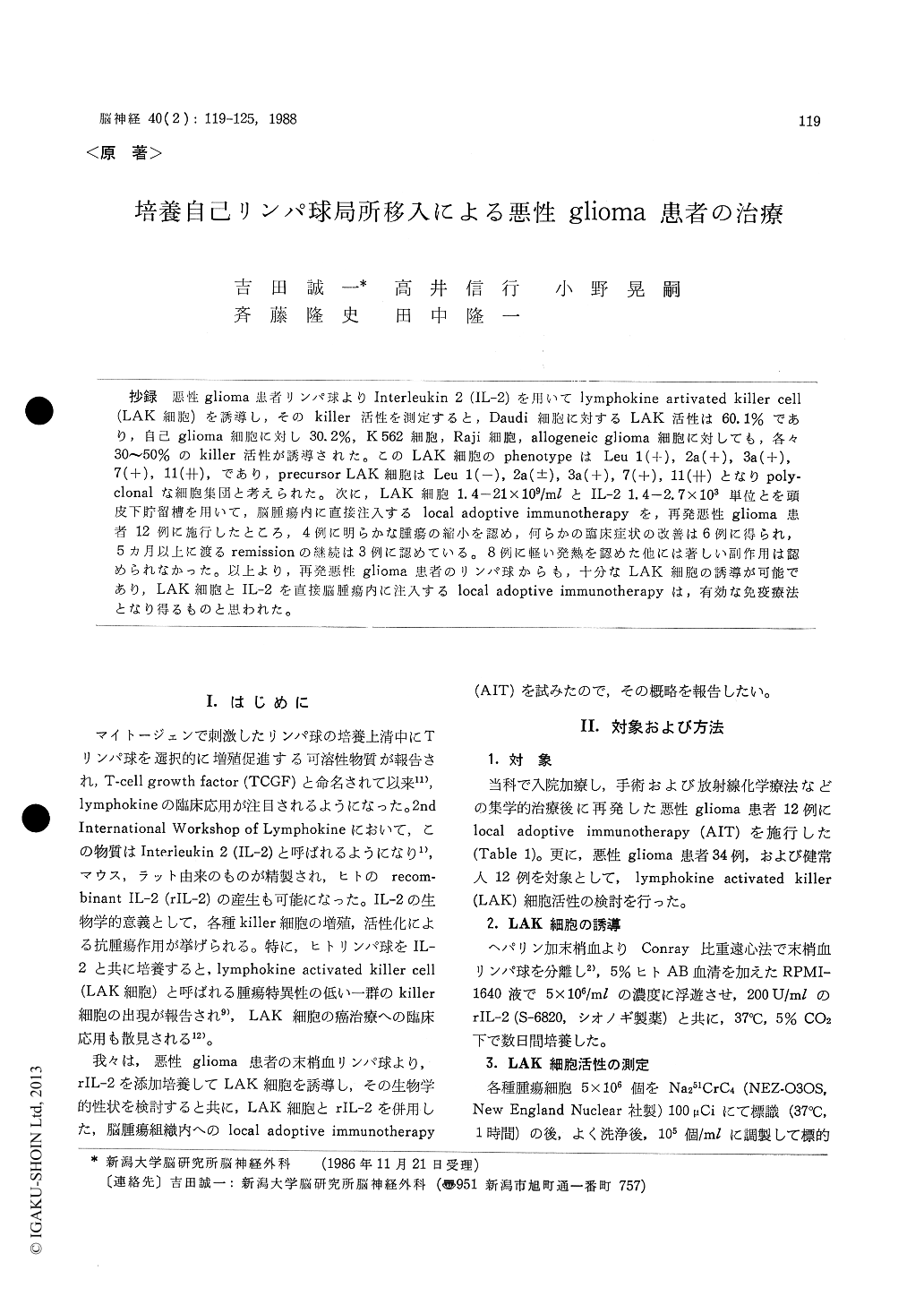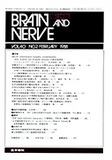Japanese
English
- 有料閲覧
- Abstract 文献概要
- 1ページ目 Look Inside
抄録 悪性glioma患者リンパ球よりInterleukin 2(IL−2)を用いてlymphokine artivated killer cell(LAK細胞)を誘導し,そのkiller活性を測定すると,Daudi細胞に対するLAK活性は60.1%であり,自己glioma細胞に対し30.2%,K562細胞,Raji細胞,allogeneic glioma細胞に対しても,各々30〜50%のkiller活性が誘導された。このLAK細胞のphenotypeはLeu 1(+),2a (+),3a (+),7(+),11(++),であり,precursor LAK細胞はLeu 1(−),2a (±),3a (+),7(+),11(++)となりpoly-clonalな細胞集団と考えられた。次に,LAK細胞1.4-21×109/mlとIL−21.4-2.7×103単位とを頭皮下貯留槽を用いて,脳腫瘍内に直接注入するlocal adoptive immunotherapyを,再発悪性glioma患者12例に施行したところ,4例に明らかな腫瘍の縮小を認め,何らかの臨床症状の改善は6例に得られ,5ヵ月以上に渡るremissionの継続は3例に認めている。8例に軽い発熱を認めた他には著しい副作用は認められなかった。以上より,再発悪性glioma患者のリンパ球からも,十分なLAK細胞の誘導が可能であり,LAK細胞とIL−2を直接脳腫瘍内に注入するlocal adoptive immunotherapyは,有効な免疫療法となり得るものと思われた。
Recently lymphocytes from patients with cancer have proved to be activated by interleukin 2 (IL-2), and show a strong cytotoxicity. On the basis of this fact, we have tried to inject lymphokine activated killer (LAK) cells and recombinant IL-2 (rIL-2) directly into the cavity of brain tumor. We describe here preliminary results of the local administration of LAK cells and the rIL-2 to pa-tients with malignant gliomas.
Lymphocytes from the patients were separated from venous blood on a Ficoll gradient. By culture with rIL-2 for five days, the lymphocytes were activated to generate LAK activity, which was measured by chronium release assay. These LAK cells were capable of killing various kinds of tumor cells including their own cells. For example, their LAK activity to Daudi cell and self tumor cells was approximately 66 and 49%, respectively. These LAK cells showed a strong killing activity in ex-cess of 40 to 70% against various tumor cells. Furthermore, activated killer cells, such as LAK cells, phytohemagglutinin-activated killer cells, and their precursor cells were serologically studied for the recognition of their biological characteristics. The phenotype of these LAK cells were sensitive to Leu 1, 3a, 7, and extremely so to 11 monoclonal antibodies, whereas LAK precursors were mainly sensitive to Leu 11 monoclonal antibodies. This observation led us to think that LAK cells be-longed to the polyclonal cell populations.
Following the fundamental studies, we applied this adoptive immunotherapy to 12 patients with malignant gliomas in whom standard therapy turned to be unsuccessful. All patients had histo-logical evidence and progressive disease in spite of standard radiochemotherapy and other treat-ments. LAK cells and rIL-2 suspended in a few microlitters of conditioned medium were injected to the tumor cavity two or three times a week for a few months. The patients received both 1.8 to 21×108 autologous LAK cells, and 8 to 16 ×104 units of rIL-2. Partial regression was ob-served in 6 cases. Tumor reduction on CT scanwas observed in 4 cases without any major side effects. In 3 of the 4 effective cases, clinical re-mission has been lasting over 5 months. Although 8 cases developed a transient slight fever there were no major unfavorable side effects observed.
We are now trying to increase LAK activity with the aid of other lymphokines. By the deve-lopment of more effective local adoptive immuno-therapy, it would become practical to maintain LAK activity, and to increase other effector cells in a tumor site. Although further development and additional follow-up are required before its therapeutic value can be established, this adoptive immunotherapy may become a new approach in the treatment of malignant brain tumors.

Copyright © 1988, Igaku-Shoin Ltd. All rights reserved.


